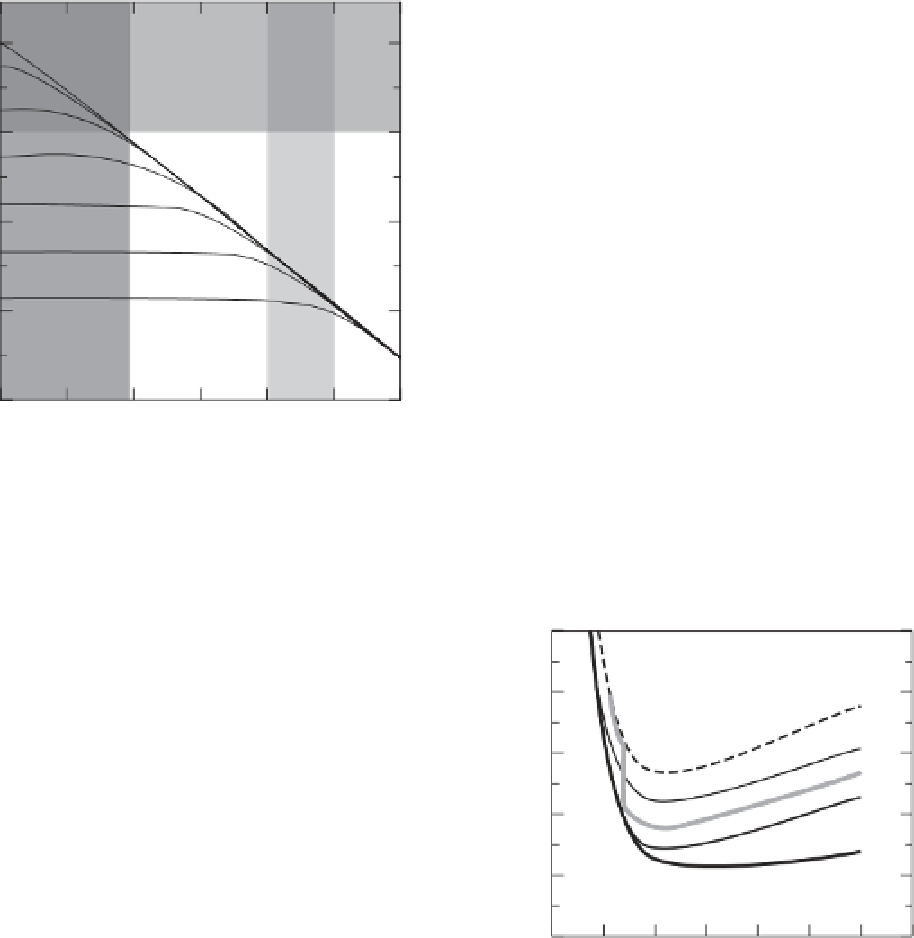Geoscience Reference
In-Depth Information
from 900K to 1600K, then the viscosity will de-
crease by
10
−
6
m
3
/mol)
(V*
dry
,
×
30
five orders of magnitude. Even if
the influence of high pressure is included, still
temperature effects dominate at relatively shal-
low regions and viscosity decreases with depth
(Figure 4.19).
In addition to the influence of temperature and
pressure, a variation in other factors such as water
content will affect the viscosity-depth profile. A
case of oceanic lithosphere is shown in Figure 4.19
where the influence of a sharp change in water
content at
∼
10
23
25
20
10
21
15
10
10
19
5
10
17
0
70 km is included as proposed by
Karato (1986) and Hirth and Kohlstedt (1996).
Karato (2012) and Karato and Jung (1998) proposed
that the layered water content can also explain
a sharp and large velocity reduction at
∼
10
15
10
−
6
10
−
5
10
−
4
10
−
3
water content, wt%
10
−
2
10
−
1
10
0
70 km.
The influence of grain-size is small because the
dominant deformation mechanism in most of the
upper mantle is likely dislocation creep judged
from the presence of seismic anisotropy.
∼
Fig. 4.18
Effect of removal of water on the change in
viscosity under the deep upper mantle (
300 km)
conditions (after Karato, 2010b). Removal of water
from initially water-rich condition (
∼
0.01 wt%) to
nearly dry conditions increases viscosity. The degree to
which viscosity changes depends on the viscosity of
dry olivine which depends on the activation volume,
V
∗
. The viscosity increases more than 10
3
if the
activation volume for dry olivine is larger than
10 cm
3
/mol. Reproduced with permission of Elsevier.
∼
10
25
s
0
=
0.1 MPa
10
23
10
21
dry
C
OH
200 ppm H/Si
=
Rheological properties are often highly nonlinear
and the effective viscosity is lower at higher stress
than at lower stress. This provides an explanation.
Second, at lower temperatures, deformation is
often localized. As a result the resistance for defor-
mation is smaller. Rifting involves deformation in
the cold lithosphere and would involve localized
deformation (e.g., Huismans & Beamont, 2003).
Third, rifting is often associated with magmatism
(e.g., Seng or & Burke, 1978). Magmatismwill pro-
vide heat and volatiles to the lithosphere and will
weaken it locally. Such a weakened region may
help rifting to initiate.
1000
4000
10
19
10
17
wet (water-saturated)
10
15
0
50
100
150
depth, km
200
250
300
350
Fig. 4.19
The depth variation in the effective viscosity
in the upper mantle (modified after Karato & Jung,
2003). A thick gray curve corresponds to a likely
viscosity-depth variation. Thin curves show the
viscosity-depth variation for a range of fixed water
content. Viscosity changes with depth due to the depth
variation in temperature and pressure, and in water
content. In this model, the water content changes from
nearly ''dry'' (zero water content) to
(c) Why is the asthenosphere weak and chemically
homogeneous?
Below the lithosphere is a weak
layer called the asthenosphere (Barrell, 1914). The
presence of such a weak layer is in large part
due to high temperature. If temperature increases
∼
1000 ppm H/Si at
∼
70 km. Reproduced with permission of Taylor &
Francis.

